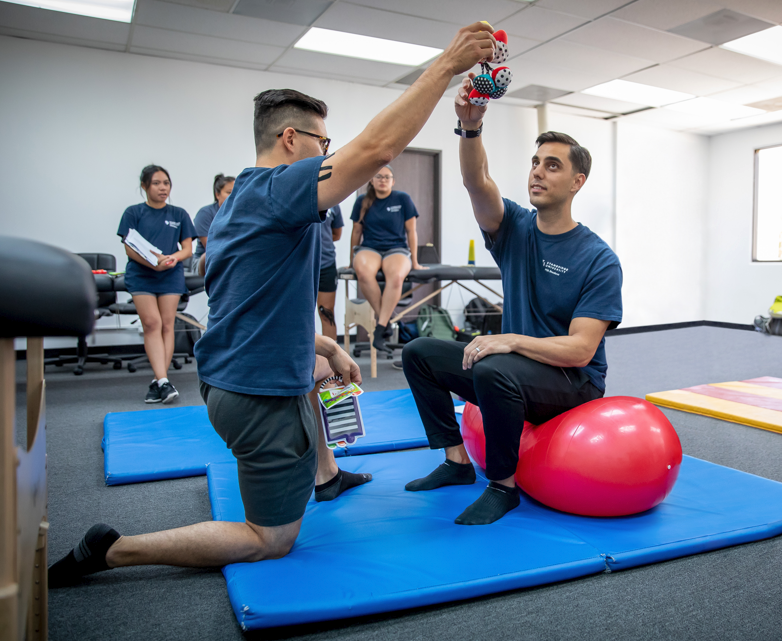The Power of Movement: What Physical Therapy Really Is
TL;DR
So, what is physical therapy? It’s a healthcare specialty that restores movement, reduces pain, and improves quality of life. Under the direction of licensed physical therapists, Physical Therapist Assistants (PTAs) help patients recover from injuries, adapt to disabilities, and regain independence.¹ In this blog post, we’ll explain what PTAs do, define physical therapy clearly, and explore four types of therapy.
When people hear the question, “What is physical therapy?”, they often think of exercises for recovery after an injury. While that’s true, physical therapy is much more than simple stretches or strength training. It’s a healthcare specialty rooted in movement science.
At its heart, physical therapy is about helping people reclaim movement, confidence, and independence after life-changing injuries, illnesses, or health challenges. It may help individuals work toward walking again, managing daily pain, or re-engaging in the activities they love.¹
In this blog post, we define physical therapy in clear terms, explore what PTAs do, and break down four types of therapy that shape patient outcomes.
What Is the Definition of Physical Therapy?
According to the American Physical Therapy Association (APTA), physical therapy is defined as treatment provided by a Physical Therapist or Physical Therapist Assistant that uses movement-based interventions to help people restore physical function, reduce pain, and prevent future injuries.² The American Physical Therapy Association emphasizes that physical therapy focuses not just on recovery, but also on overall wellness and preventative care.³
But how does physical therapy work? It blends science and human movement. Through exercise, manual therapy, education, and technology, physical therapy teaches patients how to strengthen their bodies, adapt to limitations, and live more active lives.¹
What Does a PTA Do?
A Physical Therapist Assistant (PTA) works directly with patients under the supervision of a licensed physical therapist, providing hands-on care that supports recovery and independence.¹ According to the Bureau of Labor Statistics (BLS), PTAs help carry out treatment plans designed by physical therapists, combining observation, exercise, and therapeutic techniques to improve patient outcomes.¹
Typical responsibilities of a PTA include:
- Observing patients before, during, and after therapy, and reporting progress to the physical therapist¹
- Guiding patients through specific exercises tailored to their plan of care¹
- Using massage, stretching, gait training, and balance exercises as part of treatment¹
- Assisting patients with devices such as walkers, canes, or braces to promote mobility¹
- Educating patients and their families on safe practices and at-home care after treatment sessions¹
Four Types of Physical Therapy
While physical therapy covers a wide range of specialties, four common categories include:
- Orthopedic Physical Therapy
Focused on musculoskeletal conditions such as fractures, joint injuries, and post-surgical rehabilitation. Exercises, manual therapy, and strength training help patients regain motion and stability.⁴ - Neurological Physical Therapy
Designed for patients with conditions such as stroke, cerebral palsy, spinal cord injuries, Parkinson’s disease, or multiple sclerosis. Neurological therapy aims to restore movement patterns, improve balance, and promote independence.⁴ - Cardiopulmonary Physical Therapy
Helps patients recovering from heart attacks, chronic obstructive pulmonary disease (COPD), or surgery. The focus is on endurance training, breathing exercises, and functional independence.⁵ - Sports Physical Therapy
Specialized in treating athletes and active individuals, this type of therapy focuses on injury prevention, rehabilitation after sports-related injuries, and performance enhancement. Techniques may include tailored exercise programs, manual therapy, and return-to-play training.⁶
Together, these categories highlight the versatility of physical therapy across healthcare settings. PTAs may work in physical therapy offices or clinics, hospitals, nursing and residential care facilities, and home healthcare services.¹
Pathways Into Physical Therapy: Education at Stanbridge University
The Associate of Science in Physical Therapist Assistant program from Stanbridge University prepares students for licensure and clinical practice. The program:
- Takes approximately 20–21 months to complete.⁷
- Combines on-ground, online, and blended learning environments.
- Offers hands-on labs in Nursing Simulation Laboratories and immersive clinical practicums in healthcare settings.
- It is available at the Orange County and Los Angeles campuses.
- It is accredited by the Commission on Accreditation in Physical Therapy Education (CAPTE).
Through Advanced Hands-On Training and High-Fidelity Simulations, Stanbridge students learn to deliver safe, effective care. Our Student Services department supports graduates with career services, including resume building, interview training, and job search support.
The Takeaway: What Is Physical Therapy and Why It Matters
Physical therapy is the science of healing through movement, delivered by a team of licensed physical therapists and PTAs who support patients in working toward greater mobility and independence². Whether you’re interested in orthopedic, neurological, cardiopulmonary, or sports specialties, the role of the PTA is essential to patient recovery. To explore your pathway into this rewarding career, learn more about Stanbridge University’s Physical Therapist Assistant program today.
Visit the Stanbridge University Physical Therapist Assistant program page to explore the full details of this accredited program. You can also reach out to us directly for personalized guidance.
Frequently Asked Questions
PTAs provide physical therapy services under the direction of licensed physical therapists. They assist with patient exercises, apply treatment techniques, and track progress.¹
Physical therapy is healthcare that helps restore movement, reduce pain, and prevent injury through exercise, education, and manual techniques.²
While physical therapy covers a wide range of specialties, orthopedic, neurological, cardiopulmonary, and sports, each is focused on restoring mobility and independence across different conditions.
Footnotes
¹Source: Bureau of Labor Statistics, U.S. Department of Labor, Occupational Outlook Handbook, Physical Therapist Assistants and Aides, https://www.bls.gov/ooh/healthcare/physical-therapist-assistants-and-aides.htm#tab-2. As viewed on August 25, 2025.
²Source: American Physical Therapy Association (APTA), The Physical Therapy Profession, https://www.apta.org/contentassets/5a330c03bbe24a999608030270ced59c/physical-therapy-overview-high-early-college.pdf. As viewed on August 25, 2025.
³Source: American Physical Therapy Association (APTA), Physical Therapists’ Role in Prevention, Wellness, Fitness, Health Promotion, and Management of Disease and Disability, https://www.apta.org/apta-and-you/leadership-and-governance/policies/pt-role-advocacy. As viewed on August 25, 2025.
⁴Source: Bureau of Labor Statistics, U.S. Department of Labor, Occupational Outlook Handbook, Physical Therapists, https://www.bls.gov/ooh/healthcare/physical-therapists.htm. As viewed on August 25, 2025.
⁵Source: American Physical Therapy Association (APTA), “What Is Cardiovascular & Pulmonary Physical Therapy?” ChoosePT, https://www.choosept.com/why-physical-therapy/specialty-areas-physical-therapy/cardiovascular-pulmonary-physical-therapy. As viewed on August 25, 2025.
⁶Source: American Physical Therapy Association (APTA), What Is Sports Physical Therapy?, ChoosePT, https://www.choosept.com/why-physical-therapy/specialty-areas-physical-therapy/sports-physical-therapy. As viewed on August 25, 2025.
⁷Program duration subject to change. Completion times vary depending on the start and end dates of a cohort and any individual circumstances that may impact progression.


